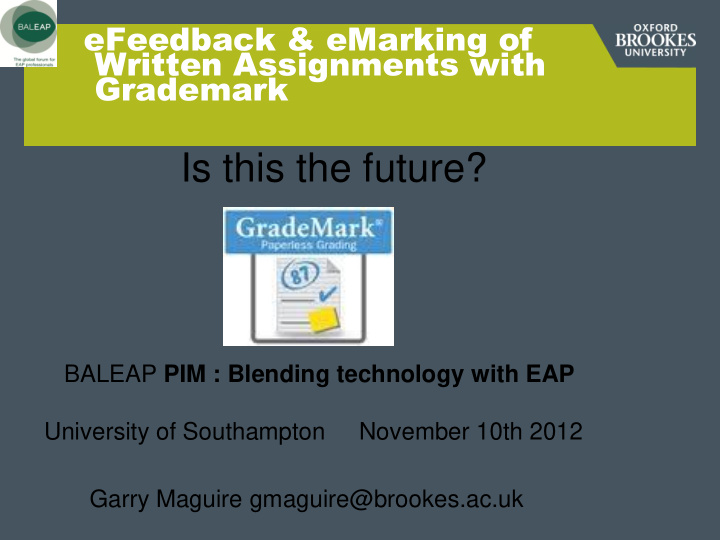



eFeedback & eMarking of Written Assignments with Grademark Is this the future? BALEAP PIM : Blending technology with EAP University of Southampton November 10th 2012 Garry Maguire gmaguire@brookes.ac.uk
Abstr Abstract act: The stage of the assessment cycle which has received particular attention recently is feedback. Grademark (http://submit.ac.uk/en_gb/products/grademark), provides a paperless feedback and assessment tool within Turnitin. Does this offer greater efficiency, effectiveness, quality and than alternative means? This talk reports on a year-long trial of eSubmission with Grademark in Oxford Brookes University with large student cohorts following in-sessional credit-bearing EAP modules. It presents an analysis of student and staff useage and evaluation of the tool as well as demonstrates how the tool is set up and how it functions. Its use with teaching teams focusing in particular on feedforward in academic literacy is explored. Technical issues are indicated and potential difficulties in assessment- related requirements and in implementation are highlighted. Recommendations for introducing and rolling out across an EAP department are offered for those considering its adoption. on trial of fully
Grademark AIM: To report on trial of fully digital formative and final assignment e Feedback and e Marking using Grademark to inform those considering adopting. report on trial of fully
Grademark eFeedback : • Accessibility ✔ • Efficiency ✔ • Effectiveness: quantity and quality ✔
Grademark eMarking : • Accessibility ✔ • Efficiency ✔ • Effectiveness: reliability ?
Using Grademark within Turnitin
Grademark compared to..? ✖ ✔ Versus
Why trial undertaken? Assignment feedback focus and Aske Brookes e-learning, Turnitin strategy Brookes Student Learning Experience strategy: accessibility Assessment compact: clause 2.8 on CPD & new technology Recurring student evaluation requests for better targeted developmental feedback Recurring environmental action point on courses note in Annual Reviews Peer Enhancement of T&L group: feedback on writing using new technology focus
30 – 130 Using Grademark : the trial students per module In-sessional Academic English Teams of up to Undergraduate Modules 9 teachers U70909 Essential Academic Writing Several written assignments U70901 Academic Reading for Writing and Speaking on each U70906 Academic Listening and Speaking U70912 Academic Writing for Science and Technology Traditional, core text types U70924 Higher Academic English Language Skills Developmental U70924 Modern Foreign Language Teaching Feedforward U70910 Academic Writing for Business priority U70923 Academic English for Business Purposes Drafting system
GradeMark: functions Quickmark = Developmental eFeedback purposes Rubric = eGrading papers / eMarking for assessment
Quickmark Tour
RubricTour
GradeMark: acceptance over trial period Academic Staff Initial misgiving soon initial reluctance replaced by acceptance – even lack of introductory training with ‘ get it out there ’ approach to initial preference for paper implementation version due to reading strategy use Now on modules not using screen fatigue GradeMark staff lobby for its use. initial slowness in processing
Using Quickmark: acceptance Student response to Quickmark (Semester 1 2011 online survey results n= 75)
Isn ’ t it impersonal..? Lecturer can insert Lecturer can add a bespoke comments & personal comment to personalise these the Quickmark bank item they use Lecturer has to select There is a general appropriate comment personal comment from bank – not written section machine-like! There is a personalised audio comment option
Isn ’ t it impersonal..? ✖ ✔ Versus
Using GradeMark: Pros Accessibility of hand in and pick up Enhances quantity and quality of feedback Efficient in marking time after initial set up Can direct towards developmental study resources Monitoring of student accessing of formative feedback possible Environmentally friendly fully digital hand in & return Administrative time saving Secure and no lost papers Functionality of Quickmark and Rubric sets - exportable Formative, developmental focus – can be used purely for feedback without plagiarism or marking focus Has integrated audio feedback Easily used for ELT/EAP correction code if applicable Anonymous marking option available External examiner access
Using GradeMark: : CONS Some resource implications in initial Quickmark/ Rubric setting and creation of bespoke student training resources Some minimal staff training required to ensure efficient use Quickmark feedback set ownership can cause significant inefficiency in useage (comment authorship and editing rights need careful thought). Turnitin follows an individual tutor approach currently. Complex weighting not straightforward to integrate with Rubric function
Rec Recommen ommendatio dations ns : Roll out BUT phased To minimise risk of rejection and maximise efficiency and optimise student experience: Phase 1: Formative Use Only Produce a university/school/subject generic Quickmark set for academic literacy / study skills developmental feedback purposes with hyperlinks to self study resources and university academic support services to then be cascaded across programme for addition of more bespoke comments to bank Adapt and expand for course level Quickmark set with Course Leader ownership and expor to individual teachers for each assignment Offer workshop/s and produce short in-house training screencast video, using this Quickmark set and an exemplar assignment for lecturers and for students
GradeMark: Provisi Provision onal al Rec Recomme ommend ndat ations ions Phase 2: Set goals of using core Quickmark set for formative feedback purposes only on ONE core programme module with guidance on optional marking using general comments. Phase 3: Roll out across all courses Set goal of using GradeMark with full Quickmark functionality and full Rubric function Phase 4: Follow Phase 1-3 for Rubric function
Conclusion on GradeMark Trial It ’ s the future! (Kay, 2011) • Potential for significant leap forward in assessment feedback for staff and students alike : Accessibility Efficiency Effectiveness • ‘ getting it out there now ’ may be counter-productive • Phase in and disseminate from centre with ready made core Quickmark and Rubric sets with support
Grademark implementation project… For further information contact: Garry Maguire gmaguire@brookes.ac.uk
Recommend
More recommend